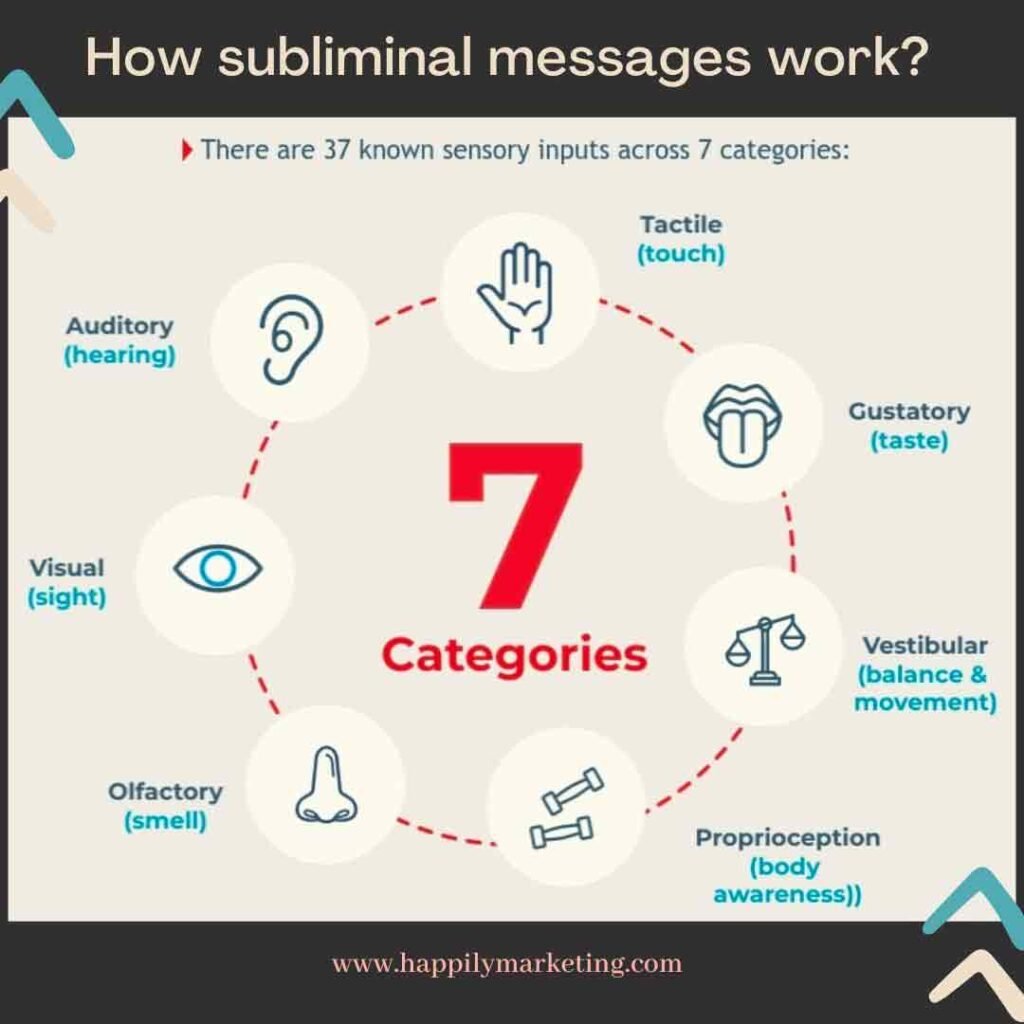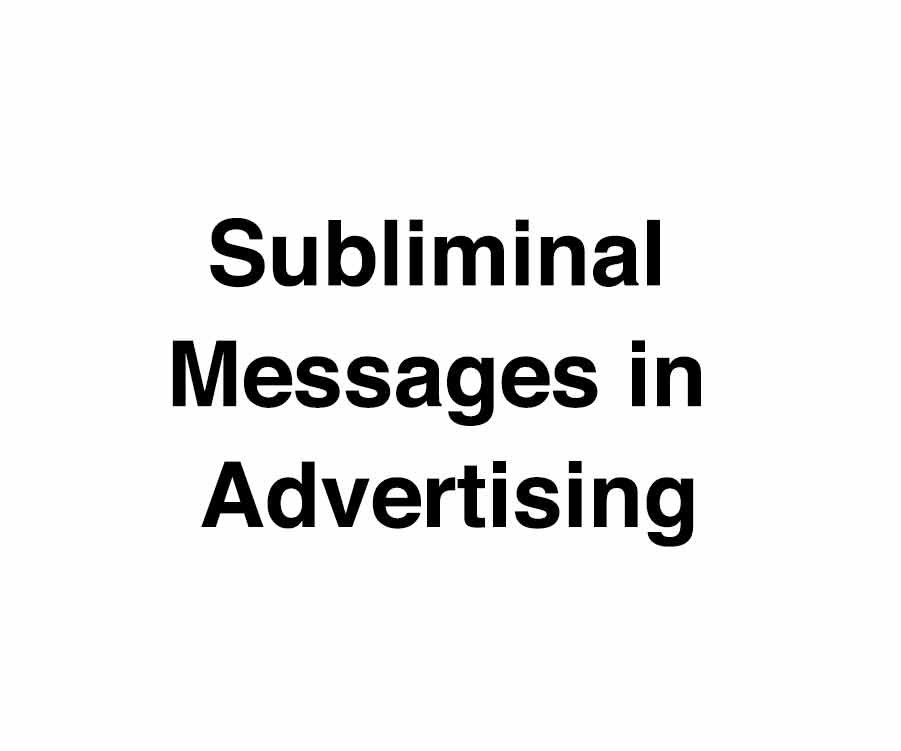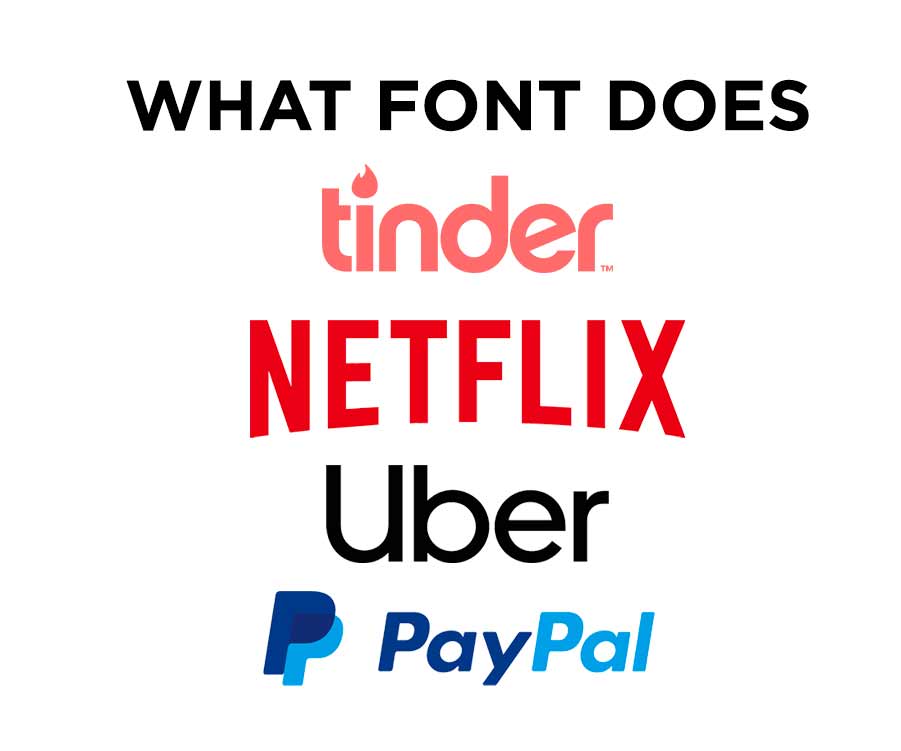This blog post is intended to teach people about Subliminal messages in advertising and how subliminal advertising affects your decision-making behavior. So without further ado, let’s dive into it.
As you may not be aware, advertisers constantly try to sneak subliminal messages into their commercials. They do this to get us to buy their products without realizing it.
But we’re on to them! This blog will explore some of the most common subliminal messages used in advertising and examples of subliminal perception.
So next time you’re bombarded with ads, you’ll know what to look for
What Is Subliminal Advertising?
Subliminal advertising or subliminal perception is a type of marketing that intentionally uses subtle messages to influence consumers. A subtle message is designed to be below the conscious level of awareness, which means that people are not consciously aware of it.
Visual or auditory stimuli make people get the message; even though people are not consciously aware of it, they can still affect their behavior and thoughts. Marketing strategy and advertising of brands these days are very good at hiding subliminal messages from customers.
One typical example of subliminal advertising is when a company uses s.e.x to sell products. This might involve using attractive models in ads or using sexually suggestive language.
The idea is that even though people are not consciously aware of the sexual message, it still affects their thinking and makes them more likely to buy the product.
Critics of subliminal ads argue that it is unfair to manipulate people in this way. They also say there is no clear evidence that subliminal messages influence people’s behavior. However, some studies have found evidence that subliminal messages can affect people’s attitudes and behavior, at least in the short term.
So, while the jury is still out on whether or not subliminal advertising is effective, it remains a controversial topic in the marketing world.
How Subliminal Messages Work

Successful subliminal advertising campaigns are carefully crafted messages designed to be below the threshold of conscious awareness. That means the conscious mind overlooks them, but the subconscious mind processes them.
It is believed that the subconscious mind is more receptive to suggestion than the conscious mind, which is why subliminal messages can be so powerful.
There is a lot of debate about whether or not subliminal messages work. Some people believe they are an effective way to influence behavior, while others believe they are ineffective or harmful.
There is some evidence that subliminal messages can influence behavior. For example, one study found that participants exposed to subliminal messages were more likely to choose a healthy snack than those not exposed to the messages.
However, it is essential to remember that subliminal messages’ effects are usually minimal. For example, most studies have found that the results of subliminal messages are fleeting and have no lasting impact on behavior.
Types of Subliminal Messages

Subliminal messages are often used in advertising to influence the consumer’s behavior. There are two main types of subliminal messages: visual and auditory. Visual messages are usually seen for a split second and are often flashed on the screen quickly. Auditory messages are typically played at a low volume so that the conscious mind cannot hear them, but the subconscious can.
Visual
There are three subliminal messages: visual, auditory, and auditory, with a visual component. Visual messages are usually flashed on the screen for a split second, too quickly for the conscious brain to process.
They are often backward or superimposed over other images. Auditory messages are played softly in the background or masked by louder sounds. Auditory subliminal messages with a visual component are called binaural beats, and they work by flashing images while playing sounds at different frequencies in each ear.
Audio
Audio subliminal messages are embedded in music or other audio recordings, usually inaudible to the conscious mind, but the subconscious can pick them up.
There is some debate about whether audio subliminal messages are effective, but there is no doubt that they have been used in advertising and other contexts. One famous example is the song “Stairway to Heaven” by Led Zeppelin, which allegedly contains the message “Here’s to my sweet Satan.”
Other examples of audio subliminal messages include:
Backmasking
This is when a message is recorded backward onto a track. It is meant to be played forwards so that the subconscious can pick up on the message while the conscious mind is distracted.
Speed listening
This involves playing an audio recording faster than normal. The idea is that the subconscious can quickly process the information than the conscious mind to pick up on the hidden message.
Subliminal affirmations:
These are positive statements that are repeated over and over again. The idea is that they will sink into your subconscious and help you to achieve your goals.
Semantic
Subliminal messages are words, images, or sounds designed to influence our thoughts and emotions without conscious awareness. Proponents of subliminal advertising claim that it can be used to persuade people to buy products or services or to change their attitudes and behavior.
One type of subliminal message is the semantic prime, a word or phrase that carries a particular meaning. For example, the term “buy” is often used in ads because it strongly associates with the idea of purchase. Other standard semantic primes include “sale,” “free,” and “new.”
Subliminal messages can also be conveyed through images and sounds. For example, an ad might use fast-paced music to get a sense of urgency or use attractive models to subconsciously suggest that the product will make you more attractive.
No scientific evidence supports the claim that subliminal messages can influence our thoughts and emotions. However, some studies have found that people are more likely to contemplate buying a product if they see an ad for it shortly before making a purchasing decision.
Examples of Subliminal Messages In Advertisement
Advertisers often use subliminal messages to influence consumers. Subliminal messages are not consciously perceived by the consumer but can still influence their thoughts and behavior. For example, a subliminal message in an ad might tell the consumer to buy the product.
Visual
One of the most common ways that subliminal messages are used in advertising is through visual means. This can involve placing images or words in an ad that are not immediately apparent to the viewer but are intended to register subconsciously.
For example, a car company might use an image of a winding road in its advertising to subconsciously suggest that its cars are suitable for taking on long journeys. Similarly, a perfume company might use an image of a rose in its advertising to subliminally tell that its product is romantic and luxurious.
Audio
The use of subliminal messages in ads is a controversial topic. Many people believe that advertisers use subliminal messages to influence consumers, while others argue that subliminal messages are not effective or that advertisers do not use them.
A few examples of subliminal messages in ads have been found. One example is a Coca-Cola ad that aired on television in the 1950s.
The ad featured a group of people singing the Coca-Cola song, and then, for a split second, the words “Drink Coca-Cola” was flashed on the screen.
Another example is an ad for McDonald’s that was aired in the 1970s. The ad featured a woman eating a hamburger, and then, for a split second, the word “hungry” was flashed on the screen.
Some studies have found that subliminal messages can influence people’s behavior. For example, one study found that people exposed to subliminal messages were likelier to choose Coke over Pepsi when given a choice between the two drinks.
However, other studies have found that subliminal messages are not effective at influencing people’s behavior.
It is difficult to say definitively whether or not advertisers use subliminal messages because it is hard to prove whether or not advertisers are purposely trying to influence consumers with subliminal messages.
However, some experts believe advertisers may use subliminal techniques without realizing it.
5 Subliminal Messages Examples Of Popular Brands
Your brain processes image 60,000 times faster than words. And advertisers know this. That’s why subliminal messages in advertising are designed to target your subconscious mind – the part of your brain responsible for your gut reactions and split-second decisions.
While subliminal messages may evoke a negative connotation, not all are bad, and some advertisers use them for good. Here are five examples of subliminal messages in advertising:
The FedEx Logo
The hidden arrow in the FedEx logo is an excellent example of a positive subliminal message. The arrow symbolizes the speed and efficiency of the FedEx brand – two things that are important to customers when choosing a shipping company.

Amazon’s Logo
You’ve probably seen Amazon’s logo before, but did you know it has a hidden message? The arrow connecting the “a” and “z” represents the variety of products you can find on Amazon.com – from A to Z.
KFC’s Hidden Dollar Bill
This is one of the most famous examples of subliminal messages in advertisements in this food network. In KFC’s old logo, there was a hidden image of a dollar bill between the “f” and “c,” – representing value and affordability. This secret message was eventually removed after customers started to catch on.

Baskin-Robbins
Baskin-Robbins is another company that uses subliminal messages in its logo. If you take a closer look at the “B” and “R,” you’ll see that they form the number 31 – which happens to be the number of flavors they offer. Clever, right?
Are subliminal messages ethical?
Subliminal messages are designed to be below the level of conscious awareness. This means that you will not be aware of the message, but it will still impact your thoughts and behavior. Traditionally, subliminal messages have been used in advertising to influence people’s buying decisions. However, there is debate about whether or not this is ethical.
The debate
The ethical debate around subliminal messages is ongoing. Some people believe that using subliminal messages in the advertisement is misleading and manipulative, while others argue that it is a perfectly acceptable way to communicate with consumers.
There is no doubt this trick can be effective subliminal advertising. For example, a study by researcher Juha-Matti Laine found that participants exposed to subliminal messages were likelier to choose the advertised product over a competing product.
However, there are also concerns about the potential for abuse. For example, what if advertisers started using subliminal messages to influence people’s political views? Or what if they began targeting children with subliminal messages?
Critics argue that these are valid concerns and that the use of subliminal messages should be regulated to protect consumers from being manipulated. For example, supporters of subliminal messaging say that it is no different from other forms of advertising and that any regulation would be overly restrictive.
Ultimately, the decision about whether or not to use subliminal messages in promotions is up to each company. As a result, some companies have decided to avoid using them altogether, while others have chosen to use them in a way that they believe is ethical and responsible.
Pros and cons of using Subliminal advertising campaigns
There are pros and cons to using subliminal messages in advertisements. On the one hand, it could be argued that it is a form of manipulation that is unethical. On the other hand, some people believe it is a harmless way to influence people’s behavior.
The jury is still out on whether or not subliminal messages are effective. Some studies have shown they can be, while others have not found any effects. It is also worth noting that the impact of subliminal messages is usually minimal.
Given the lack of conclusive evidence and ethical concerns, many companies choose not to use subliminal messages in their advertising.
How To Spot Subliminal Messages in Advertising
Subliminal messages are often used in advertising to deliver hidden messages to consumers. This message is usually about the product being advertised. For example, a shampoo commercial might use subliminal messages to suggest that the product will make your hair shinier and softer.
Be Aware Of The Techniques Used.
Subliminal messages are often used in advertising to influence our purchasing decisions without realizing it. While some subliminal messages are harmless, others can be manipulative and deceptive.
Here are some standard techniques that are used to embed subliminal messages in advertising:
Hidden images:
This is perhaps the most common type of subliminal message. Hidden photos are usually inserted into the background of an image or video, and they can be tough to spot. They may be of a sexual or violent nature, or they could be designed to trigger a particular emotional response.
Backward masking:
This technique whereby words or music are played backward to conceal a message is only revealed when the sound is played in reverse. This technique is often used in rock music, and it can be used to deliver either positive or negative messages.
Inaudible messages:
These are messages played at a frequency below the level of human hearing. Special equipment can detect them, but they can still affect our behavior. Inaudible messages are sometimes used with other techniques, such as backward masking.
If you’re concerned about subliminal messages in advertising, you can best be aware of the techniques used to embed them. By doing this, you’ll be better able to spot them and make your own decisions about whether or not you want to take notice of them.
Pay Attention To The Details.
Watching TV or browsing the internet makes it easy to get caught up in the plot or the ad’s overall message and miss the minor details.
However, many times it’s these smaller details that contain the subliminal message. Paying attention to the background, the color scheme, and even the people in the ad’s facial expressions can give clues about what message the advertiser is trying to send.
Other things to look for are patterns or images flashed onscreen for a split second. These images are called “Subliminals” because they are below our conscious level of awareness.
However, they can still register in our brains and influence our subconscious thoughts and emotions. For example, some common Subliminals used in advertising include images of violence and celebrities.
If you think you’ve spotted a subliminal message in an ad, take a closer look at it and see if you can figure out what message the advertiser is trying to send.
History Of Subliminal Messages
The history of subliminal messages is long and controversial; some believe that subliminal messages have been used for centuries, while others think that the concept is relatively new.
Subliminal messages are any communication that is designed to influence the subconscious mind. This can be done in several ways, including through music, images, and even words.
Some believe that subliminal messages were first used in wartime propaganda. This message was designed to influence the emotions of soldiers to make them more likely to fight.

Subliminal messages began to gain popularity in the 1950s when market researcher James Vicary studied how subliminal messages could influence consumer behavior.
Vicary claimed that he could increase popcorn and Coke sales by flashing words like “Eat Popcorn” and “Drink Coke” on a screen during a movie. Though Vicary’s study was later debunked, it led to much public interest in the power of subliminal messaging.
Advertisers began experimenting with subliminal messages to increase sales, and several controversial campaigns utilized this messaging.
In 1957, an ad campaign for Life magazine flashed the words “Get It” and “s*x” during an image of a woman getting dressed. In 1974, a Pepsi ad included the terms “You’re tired” during a picture of someone drinking Pepsi.
And in 2002, Burger King ran an ad campaign that included the phrase “Hungry? prone Grab a Whopper” during images of people sleeping.
Despite the public interest in subliminal messaging, little scientific evidence supports the claim that these messages can influence behavior. However, this has not stopped advertisers from using this messaging in their campaigns.
Final Words
Subliminal messages are everywhere. They’re in the music we listen to, the movies we watch, and the ads we see. And while there is debate about whether or not they work, advertisers continue to use them in their campaigns.
Nowadays, digital marketing is a powerful tool that can be used to influence people’s subconscious thoughts and emotions. While little scientific evidence supports the claim that subliminal messages can influence behavior, this has not stopped advertisers from using this messaging in their campaigns.
By being aware of the techniques used to embed these messages, you can better protect yourself from their effects.
Read More
- 21+ Trucker Logo Design Ideas For Your Inspiration
- 20+ Best Logos With Apples For Your Inspiration
- 25+ Best Ranch Logo Design Ideas
- 15 Amazing Trucker Logo Design Ideas For You
- 17+ Vintage Fonts For Logo : Fresh Retro Font Style







